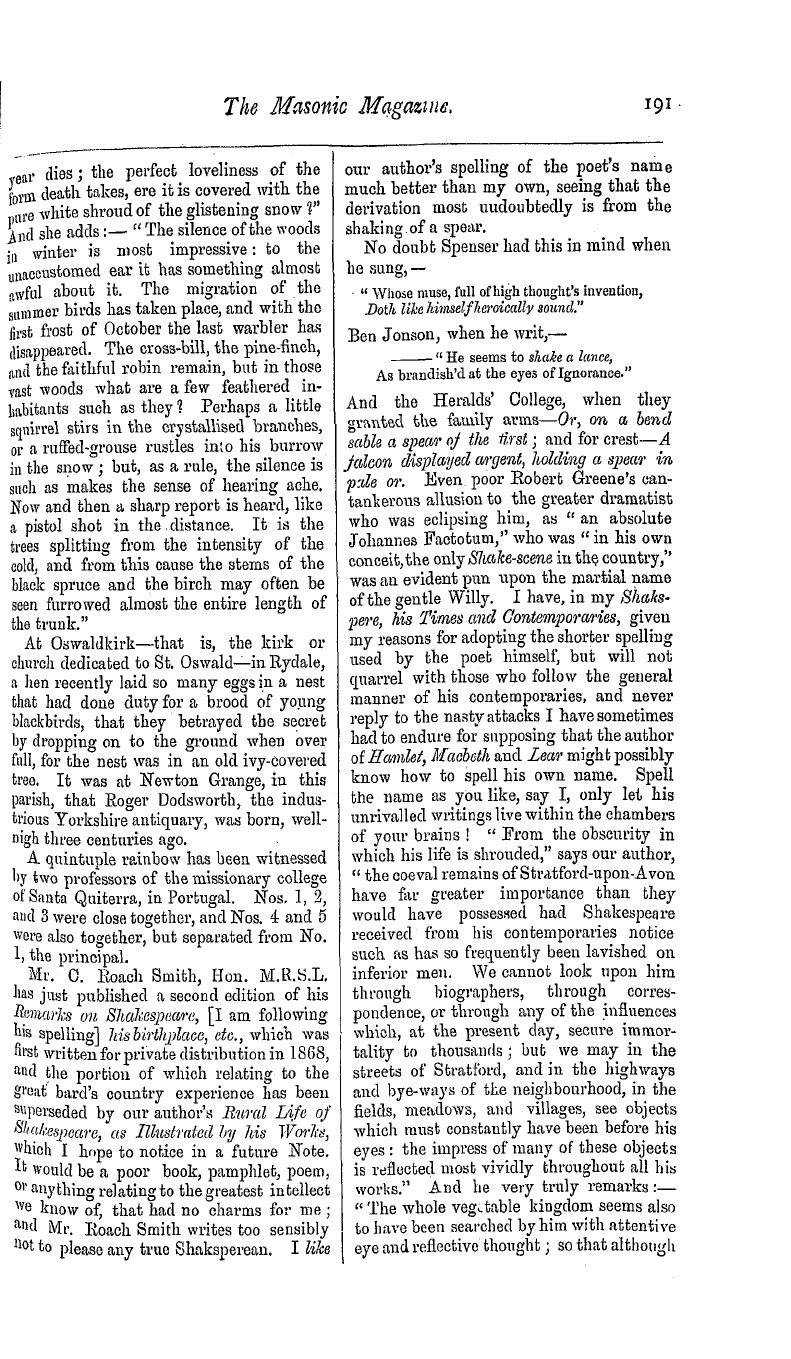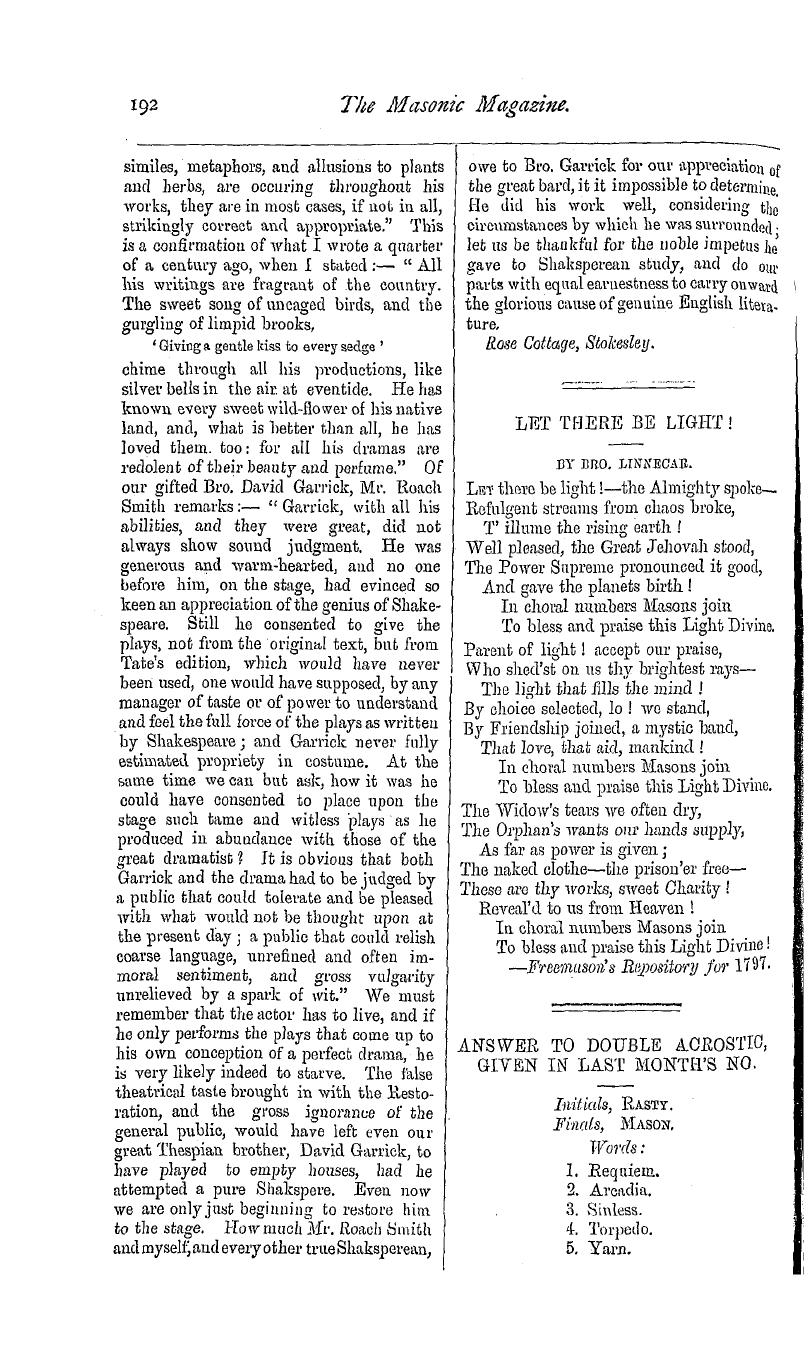-
Articles/Ads
Article THE TRUE MASON. ← Page 2 of 2 Article THE MASONIC LANGUAGE OF FLOWERS. Page 1 of 3 →
Note: This text has been automatically extracted via Optical Character Recognition (OCR) software.
The True Mason.
With the Square and the Plumb-lead as emblems to guide him , From the line of strict duty ho scorns to depart ; With the Rule and the Compass both ready before him , He rears a true Temple of God in his heart .
His thoughts are as pure as the snow when it falleth ; His zeal is enlisted on rectitude ' s side ; No fear of men ' s scoffing , his courage appalleth , As he stands the oppressed and the friendless beside .
At the cry of misfortune his love is awakened ; Large-minded , he succours , with naught of display ; The widow , the orphan , the hungry and naked , From Ms portals are never sent empty away .
In precept though firm , he is soft as a mother , Who seeks in affection her offspring to mould ; More apt by example to win a lost brother , And waverers keep in the Good Shepherd's fold .
Unsullied by contact with lusts that surround him , Large-hearted , he loves with a God-like regard ; He lives a rich blessing to all who are round him , And dies to receive the true Mason's reward .
The Masonic Language Of Flowers.
THE MASONIC LANGUAGE OF FLOWERS .
From the " Keystone . " WE are in the midst of a season of bloom . From the clover , that modestly raises its blossoms but a few inches above the earth ' s surface , to the chestnut tree , that shoots its branches high into the air , and is covered with a mass of flowery sprays , all Nature is blooming . The wild rose opens its
petals by the road-side and in the woodlands ; the water-lily floats miraculousl y ; the mill-ponds ; and countless blades of grass cover the earth and carpet it with verdure . There appears to be no inanimate Nature , for each flower and tuft of grass
every bush and tree is vigorous with life , And man is everywhere appreciatin g it . In the public parks and rural districts , by mountain , brook and seaside , the Summer holiday is being heartily enjoyed . Whether it be for but a clay ' s excursion , or for a week
or month ' s stay " out-of-town , " every one is sharing in the spectacular feast which Nature bountifully offers to every eye . We would call the reader ' s attention to a few flowers and shrubs in this connection that bear a Masonica mysticor a sacred
, , character . There is an abundance of these , and at this flowery season we cannot do better than concentrate thought upon a few of the most conspicuous , of them , for they suggest recollections and reflections that are at once entertaining and instructive .
The Lotus , or water-lily , is perhaps the most noted of mystic flowers . It was revered in all the secret systems of the East . In India , Java , China and Egypt this * '
immortal plant , as Ovid calls it , with its majestic form , its heart-shaped leaves , and its resplendent flower , is commemorated in the sacred writings , in the hieroglyphics , in the architecture of the temples , and in divers other works of art . In our lodge roomswherever Egyptian architecture is
, exemplified , there we find the sacred Lotus . We observe it when we are at labour , and it is becoming that we should be familiar with its mysterious significance . The Lotus ivas the Rose of Ancient Egypt , and the favourite flower of the
country . It was sacred to Osiris and Isis , and symbolized the residence of the gods . Accoiding to Homer , Jupiter and Juno made their couch upon the blooming cups of water-lilies , and the horses of Achilles regaled themselves upon them . Ulysses ,
in his wanderings , visited the land of the Lotus-Eaters , and his companions were defamed through the magic influence of these flowers , and what appeared to be their fruit , on the African coast , where this people dwelt . It seems that whoever partook of them never wished to return to his native land . The Arabs have wrought this poetical idea into their estimate of the
Note: This text has been automatically extracted via Optical Character Recognition (OCR) software.
The True Mason.
With the Square and the Plumb-lead as emblems to guide him , From the line of strict duty ho scorns to depart ; With the Rule and the Compass both ready before him , He rears a true Temple of God in his heart .
His thoughts are as pure as the snow when it falleth ; His zeal is enlisted on rectitude ' s side ; No fear of men ' s scoffing , his courage appalleth , As he stands the oppressed and the friendless beside .
At the cry of misfortune his love is awakened ; Large-minded , he succours , with naught of display ; The widow , the orphan , the hungry and naked , From Ms portals are never sent empty away .
In precept though firm , he is soft as a mother , Who seeks in affection her offspring to mould ; More apt by example to win a lost brother , And waverers keep in the Good Shepherd's fold .
Unsullied by contact with lusts that surround him , Large-hearted , he loves with a God-like regard ; He lives a rich blessing to all who are round him , And dies to receive the true Mason's reward .
The Masonic Language Of Flowers.
THE MASONIC LANGUAGE OF FLOWERS .
From the " Keystone . " WE are in the midst of a season of bloom . From the clover , that modestly raises its blossoms but a few inches above the earth ' s surface , to the chestnut tree , that shoots its branches high into the air , and is covered with a mass of flowery sprays , all Nature is blooming . The wild rose opens its
petals by the road-side and in the woodlands ; the water-lily floats miraculousl y ; the mill-ponds ; and countless blades of grass cover the earth and carpet it with verdure . There appears to be no inanimate Nature , for each flower and tuft of grass
every bush and tree is vigorous with life , And man is everywhere appreciatin g it . In the public parks and rural districts , by mountain , brook and seaside , the Summer holiday is being heartily enjoyed . Whether it be for but a clay ' s excursion , or for a week
or month ' s stay " out-of-town , " every one is sharing in the spectacular feast which Nature bountifully offers to every eye . We would call the reader ' s attention to a few flowers and shrubs in this connection that bear a Masonica mysticor a sacred
, , character . There is an abundance of these , and at this flowery season we cannot do better than concentrate thought upon a few of the most conspicuous , of them , for they suggest recollections and reflections that are at once entertaining and instructive .
The Lotus , or water-lily , is perhaps the most noted of mystic flowers . It was revered in all the secret systems of the East . In India , Java , China and Egypt this * '
immortal plant , as Ovid calls it , with its majestic form , its heart-shaped leaves , and its resplendent flower , is commemorated in the sacred writings , in the hieroglyphics , in the architecture of the temples , and in divers other works of art . In our lodge roomswherever Egyptian architecture is
, exemplified , there we find the sacred Lotus . We observe it when we are at labour , and it is becoming that we should be familiar with its mysterious significance . The Lotus ivas the Rose of Ancient Egypt , and the favourite flower of the
country . It was sacred to Osiris and Isis , and symbolized the residence of the gods . Accoiding to Homer , Jupiter and Juno made their couch upon the blooming cups of water-lilies , and the horses of Achilles regaled themselves upon them . Ulysses ,
in his wanderings , visited the land of the Lotus-Eaters , and his companions were defamed through the magic influence of these flowers , and what appeared to be their fruit , on the African coast , where this people dwelt . It seems that whoever partook of them never wished to return to his native land . The Arabs have wrought this poetical idea into their estimate of the
















































